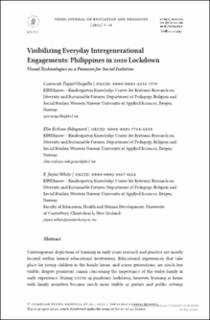| dc.contributor.author | Oropilla, Czarecah Tuppil | |
| dc.contributor.author | Ødegaard, Elin Eriksen | |
| dc.contributor.author | White, Jayne | |
| dc.date.accessioned | 2023-03-02T11:40:53Z | |
| dc.date.available | 2023-03-02T11:40:53Z | |
| dc.date.created | 2022-10-28T14:43:12Z | |
| dc.date.issued | 2022 | |
| dc.identifier.citation | Oropilla, C. T., Ødegaard, E. E., & White, E. J. (2022). Visibilizing Everyday Intergenerational Engagements: Philippines in 2020 Lockdown. Video Journal of Education and Pedagogy, 7(1), 1-21. | en_US |
| dc.identifier.issn | 2364-4583 | |
| dc.identifier.uri | https://hdl.handle.net/11250/3055312 | |
| dc.description.abstract | Contemporary depictions of learning in early years research and practice are mostly located within formal educational institutions. Educational experiences that take place for young children in the family home, and across generations, are much less visible, despite persistent claims concerning the importance of the wider family in early experience. During covid-19 pandemic lockdown, however, learning at home with family members became much more visible as private and public settings coalesced. In the present study 2-4-year-old Filipino children’s intergenerational experiences at home during lockdown were shared through visual data, as a source of valued learning—highlighting the pedagogical role of family. The authors’ interest in this article is to explore what kinds of learning were made visible—by whom, for whom. Special emphasis is given to intergenerational engagements between young children and older adults, as represented by the families themselves. Heywood and Sandywell’s concept of ‘visibilization’ is operationalized as a visual route to these sites of production—the images themselves, their intended audience, and their circulation. Videos produced by families portray intergenerational arenas for learning. The mediating role of the sandwich generations in these intergenerational encounters are made visible in the private and public sphere of social media. | en_US |
| dc.language.iso | eng | en_US |
| dc.rights | Navngivelse 4.0 Internasjonal | * |
| dc.rights.uri | http://creativecommons.org/licenses/by/4.0/deed.no | * |
| dc.subject | Covid-19 | en_US |
| dc.subject | Covid-19 | en_US |
| dc.subject | Barn i familie | en_US |
| dc.subject | The child in the family | en_US |
| dc.subject | Barndom | en_US |
| dc.subject | Childhood | en_US |
| dc.subject | Generasjonsmøte | en_US |
| dc.subject | Intergenerational engagement | en_US |
| dc.title | Visibilizing Everyday Intergenerational Engagements: Philippines in 2020 Lockdown | en_US |
| dc.type | Peer reviewed | en_US |
| dc.type | Journal article | en_US |
| dc.description.version | publishedVersion | en_US |
| dc.rights.holder | © Czarecah Tuppil Oropilla et al., 2022 | en_US |
| dc.subject.nsi | VDP::Pedagogiske fag: 280 | en_US |
| dc.subject.nsi | VDP::Education: 280 | en_US |
| dc.source.pagenumber | 1-21 | en_US |
| dc.source.volume | 7 | en_US |
| dc.source.journal | Video Journal of Education and Pedagogy | en_US |
| dc.source.issue | 1 | en_US |
| dc.identifier.doi | 10.1163/23644583-bja10032 | |
| dc.identifier.cristin | 2066145 | |
| dc.relation.project | Norges forskningsråd: 275575 | en_US |
| cristin.ispublished | true | |
| cristin.fulltext | original | |
| cristin.qualitycode | 1 | |

